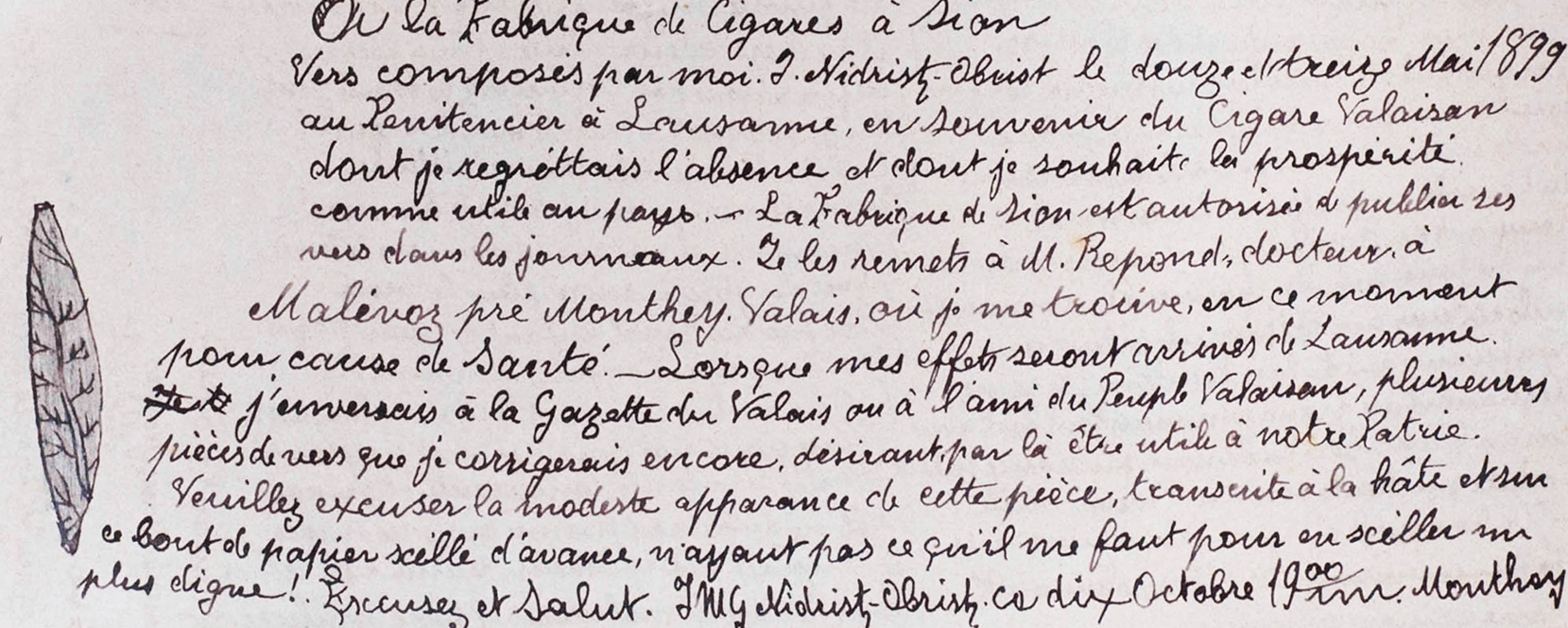
Galerie
Liste Kulturgüterinventar Wallis
Institutions Psychiatriques du Valais Romand, Hôpital de Malévoz
Sammlung Malévoz
Die maison de santé de Malévoz stellte im Jahr ihrer Gründung 1901 eine Besonderheit dar, da sie zugleich private Stiftung des Psychiater Paul Repond (1856–1919) als auch, mit anfänglich zwanzig vom Kanton finanzierten Plätzen, kantonale Klinik des Wallis war. Paul Repond, 1884–1897 Direktor des Asile de Marsens, war mit dem Pavillonstil jener Klinik vertraut. Die steile Hanglage der maison de santé de Malévoz erforderte jedoch eine Anpassung, so dass die Pavillons in der Art eines kleines Dorfes im Kastanienpark verteilt liegen. Malévoz, mit 60 Plätzen eröffnet, wurde bald auf 250 Plätze vergrössert. Es gab ein Haus für „pensionnaires“ (Privatpatientinnen und -patienten), die zwischen 1901–1930 zwischen fünf und fünfundzwanzig Franken pro Tag zu entrichten hatten und Pavillons für Patientinnen und Patienten der zweiten und dritten Klasse, die zwischen drei bis fünf Franken zu zahlen hatten. 1916 übergab Paul Repond die Direktion an seinen Sohn, den Psychiater André Repond (1886–1973, Direktor der maison de santé de Malévoz 1916–1961), der soeben im Zürcher „Burghölzli“ seine Ausbildung abgeschlossen hatte. In Malévoz beschäftigten sich Patientinnen und Patienten mit Haus- oder Gartenarbeiten oder in der Buchbinderei. Ebenfalls wird erwähnt, dass sie zeichneten, Klavier spielten, stickten oder strickten. Von total ca. 5’800 Krankenakten bis 1930 wurde ein Fünftel (1’073 Akten) untersucht. Es fanden sich 38 Werke. Die Aufenthaltsdauer in Malévoz war auffallend kurz, oft bedeutend weniger als ein Jahr. Möglicherweise nahmen Patientinnen und Patienten die Werke beim Austritt mit nach Hause.
Literatur
Repond André, La maison de santé de Malévoz, Zürich, Verlag Eckhardt & Pesch, 1935
Fussinger, Catherine, Tevaearai, Deodaat, Leux de folie – Monuments de raison. Architecture et psychiatrie en Suisse romande, 1830-1930, Lausanne1998, S. 92-100; S. 152-157

Galerie
Institutions Psychiatriques du Valais Romand, Hôpital de Malévoz
Collection Malévoz
When it was established in 1901, “Malévoz mental asylum” was a particular kind of institution at the time: it was both a private hospital, founded by the psychiatrist Paul Repond (1856–1919), and served as the psychiatric hospital of the Canton Valais, initially housing twenty government-funded patients. Repond, previously director of Marsens mental hospital (1884–1897), was familiar with a pavillon-style institution. Situated on a steep hillside, Malévoz, however, required certain architectural adjustments, so that the pavillons were spread across a park populated by old chestnut trees and thus resembled a village. Initially designed to accommodate 60 patients, Malévoz was soon enlarged to house 250 patients. Among the buildings were a house for “pensionnaires” (private patients), who were charged five to twenty-five francs a day in the period 1901–1930, and pavillons for second- and third-class patients, whose daily rate was three to five francs. In 1916, Repond handed over as director to his son André (1886–1973, director 1916–1961), who had just completed his training as a psychiatrist at the Burghölzli Psychiatric Hospital in Zürich. Besides his interest in psychoanalysis, André Repond propagated psychohygiene and delivered lectures on the prevention of mental diseases to audiences from all reaches of strata. At Malévoz, patients were involved in farming, housekeeping, gardening, and bookbinding activities. Other activities on record are drawing, piano playing, embroidering, and weaving. Compared to other psychiatric clinics, patient stays at Malévoz were brief, often lasting only one to a few months. The clinic archive has survived intact. Of the 3193 files on patients admitted between 1901 and 1930, roughly one third were examined (1073 files). These included 28 works, but no larger groups of works.
References
Répond André, La maison de santé de Malévoz, Zürich, Verlag Eckhardt & Pesch, 1935
Fussinger, Catherine, Tevaearai, Deodaat, Leux de folie – Monuments de raison. Architecture et psychiatrie en Suisse romande, 1830-1930, Lausanne1998, pp. 92-100; pp. 152-157
Pozzi, Cathérine, Journal 1913-1934, Paris 1990
Zbinden, J.-D., L’organisateur, André Repond (1886-1973), in: Müller, Christian (ed.), Portrait de psychaitres romands, Lausanne 1995, pp. 9-75

Galerie
Institutions Psychiatriques du Valais Romand, Hôpital de Malévoz
Collection Malévoz
Lors de sa fondation, la Maison de Santé de Malévoz présentait la particularité d’être à la fois une fondation privée du psychiatre Paul Repond (1856-1919) et la clinique cantonale du Valais, disposant de 20 places financées par le canton. Le Dr. Paul Repond qui avait été directeur de l’asile de Marsens de 1884 à 1897 connaissait donc le style « pavillonnaire » de cet asile. Mais à Malévoz il fallait s’adapter au terrain qui était très raide : les pavillons y sont disséminés dans une forêt de châtaigniers et se présentent comme un petit village. Hébergeant initialement 60 patients, Malévoz fut agrandi peu après son ouverture pour offrir 250 places. On y trouvait une maison pour « pensionnaires » (patientes et patients privés), qui payaient entre 19’1 et 1930 cinq à vingt-cinq francs par jour. On y trouvait également des pavillons pour patientes et patients de deuxième et troisième classe dont la contribution s’élévait à trois à cinq francs par jour. En 1916 la direction passa de Paul Repond à son fils, le psychiatre André Repond (1886-1973) qui venait de terminer ses études au « Burghölzli » de Zurich. Il dirigea la Maison de Santé de Malévoz de 1916 à 1961. A Malévoz les patientes et patients s’occupaient de travaux ménagers et de jardinage ou travaillaient à l’atelier de reliure. On apprend également qu’ils faisaient du dessin, jouaient du piano ou qu’ils brodaient ou tricotaient. D’un total d’environ 5800 dossiers de malades en 1930 nous en avons analysé un cinquième, soit 1073 dossiers. On y a trouvé 38 oeuvres. La durée de séjour à Malévoz étant remarquablement courte – souvent beaucoup moins d’une année – on peut s’imaginer que les patientes ou patients emportaient leurs oeuvres lors de leur sortie de la Maison de Santé.
Références
Repond André, La maison de santé de Malévoz, Zürich, Verlag Eckhardt & Pesch, 1935
Fussinger, Catherine, Tevaearai, Deodaat, Leux de folie – Monuments de raison. Architecture et psy-chiatrie en Suisse romande, 1830-1930, Lausanne1998, S. 92-100; S. 152-157.